Exhibited.
RMIT project Gallery, Melbourne 2003 as part of “House of the Future”
+
The Moores Building Fremantle as part of the Biennale of Electronic Arts Perth 2004.
+
The Performance Space as part of “What Survives” 2006.
Medium.
Interactive Sound-Sculpture – plastics, metal and audio-electronics.
Notes ~ Fictionalising Fiction!.
In the beginning;
As a thirteen year old lad I was once left to kick my heels for the day in central London, along with a couple of friends. Being both wary of getting lost in the capital and having little or no money we decided to visit the cartoon cinema that in those days was housed on the main concourse of Victoria station. Somehow, our encounter was not, as we had imagined, with Bugs Bunny or the Invisible Man (as it was each Saturday morning) but with something indescribable and utterly alien. I left the cinema with mixed emotions no longer an innocent for I had seen Godard and my experience of cinema had been changed irrevocably!
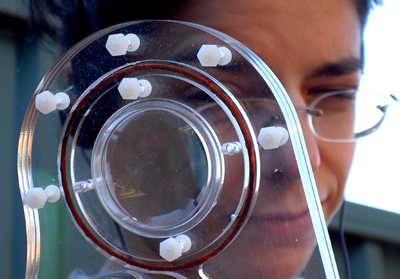
Many years later (in 2003) whilst a Visiting Fellow at Stanford University) I constructed a ‘miniature’ audio project entitled ‘One or Two Things…’ which was subsequently exhibited at London’s South Bank Centre as a feature of the ‘School of Sound’ festival (April 2003).
This work, the conceptual forerunner of “The Naughty Apartment”, consisted of a series of seven miniature reconstructions of my favourite scenes from Godard films, each reconstruction encased in a small glass dome mounted atop a vintage wooden camera tripod and equipped with a hidden audio transducer. Visitors were provided with a hand-held device sporting a magnifying glass (to better view the miniature scenes) and a loop-antenna that was designed to ‘pick-up’ the audio track accompanying each scene.
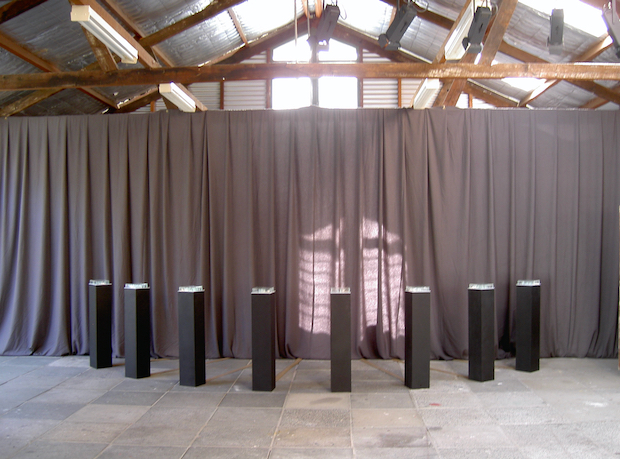
The issue at stake was how we deal and engage with the fictional spaces and narratives of cinema – in fact how we incorporate and ‘carry’ these fictions within us. During the construction of ‘One or Two Things’ I realised that I held two wildly inaccurate assumptions.
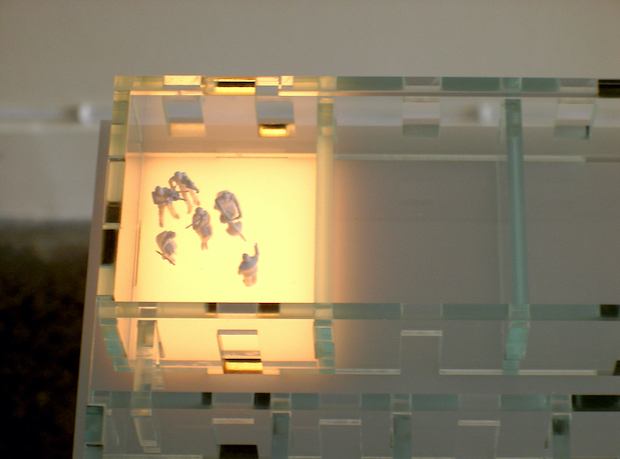
Surprise number one;
as I attempted to locate the scenes and sequences that I recalled so well, I was to discover that they, for the most part did not actually exist in Godard’s works per se and the images that I had internalised (and held so dearly) were hybrid forms, embroidered, imploded and super-imposed; this was somewhat sobering!
Wildly inaccurate assumption, number two;
again, as I attempted to transpose these filmic narratives into (miniature) sculptural dioramas a second form of slippage occurred as I realised that the discontinuous narrative that constitutes film proved only uneasily congealed into a sculptural tableau. A filmic event constructed via montage appears strangely like a Medieval ‘continuous narrative’ frieze when it is recruited as a three dimensional form. Likewise, in the sonic domain – soundtracks were re-constituted on the Procruste’s bed of my memory and neatly sutured into place with digital surgery.
‘The Naughty Apartment’ attempts a similar approach to fiction – but here the ‘original’ being a text is even more open to the re-constructive imagination – the principal irony being that the central venue of the novel was and remains a physical architectural reality!
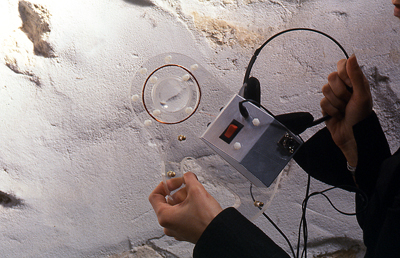
The Naughty Apartment:
I am one of those readers who become obsessed with certain authors and who rapidly exhaust their oeuvre (naturally becoming despondent when the supply of novels dries up!). The Russian writer Mikhail Bulgakov is one of these passions and in particular the magic realist novel “The Master and Margarita” which was completed in 1940 (but only published in 1966 and which caused a sensation in Soviet culture).
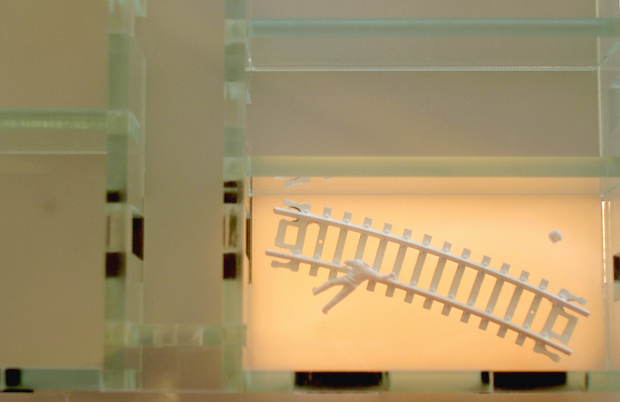
To cut a long and complicated story short “The Master and Margarita” is an allegorical and darkly satirical tale of a visit to Moscow by Satan and his entourage to conduct “Satan’s Ball”. Much of the action unfolds within the writer’s own apartment (the infamous apartment No.50 of 302-bis Sadovaya Street).
As fate would have it the Bulgakov apartment still exists and currently enjoys a shrine like status – a site of pilgrimage for Bulgakov buffs in fact “The Naughty Apartment” (which is the title of chapter 7 of the novel) was originally proposed as a project to the manager of the Moscow apartment (but that’s another story!).
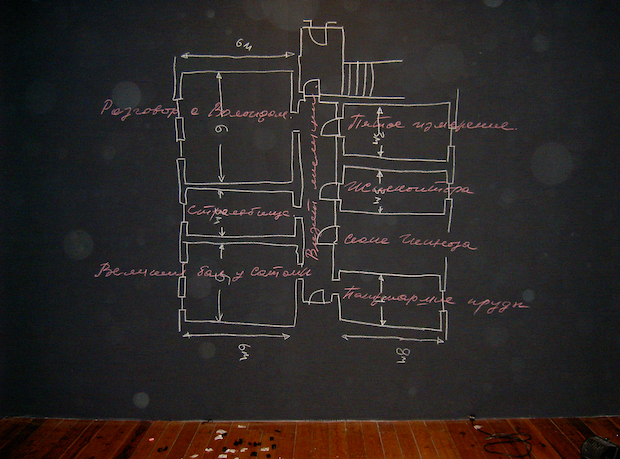
“The Naughty Apartment” is for me an exploration of architectural space in the realm of fiction and fiction within architectural space! I have never visited No.50 of 302-bis Sadovaya Street in person but my good friend Andrei was able to draw a rough plan of it on the back of an envelope between drinks, this was close enough as I had for many years inhabited the rooms of that apartment, knew the creaks in its floors and kitchen odours!
Each of the eight rooms spread before you contain a vital scene from the novel, the dramatic events elaborated by an audio narrative, written in the very same apartment building ~ perhaps as Bulgakov would have it, in the 5th Dimension!
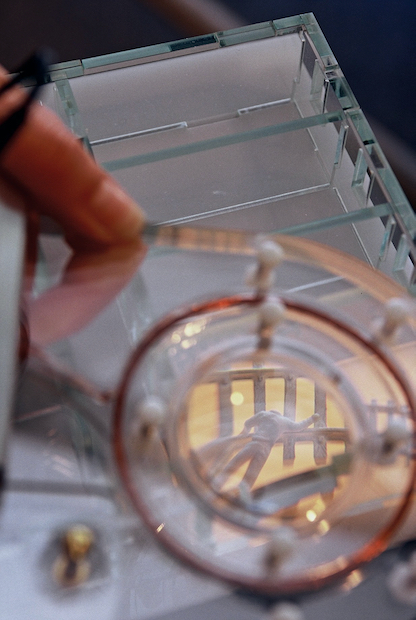
Post scriptum ~ for the technically curious:
the transmission of the sound-scape is simple. Each of the laser-cut acrylic model apartments conceal a simple wire loop antenna, which although ‘powered’ by an audio signal in fact emits only a weak, local electromagnetic field (i.e. the models do not make any sound per se). Each hand-held unit contains both a magnifying glass and matching coil-antennae (surrounding the lens) that when placed in close proximity to the model’s antenna is, in turn, energised by the electromagnetic field. The resulting signal is processed by a small audio amplifier (located within the magnifiers handle) and send to headphones.
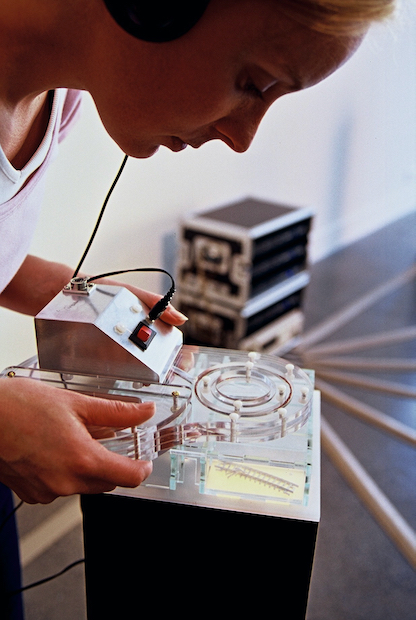
Whilst technologically simple this method of audio transfer via electromagnetic induction is quite beguiling in operation and creates a quasi-magical effect similar to the ethos of the novel itself!
© Dr Nigel Helyer, Sydney June 2003.
Some sample tracks from the Naughty Apartment.